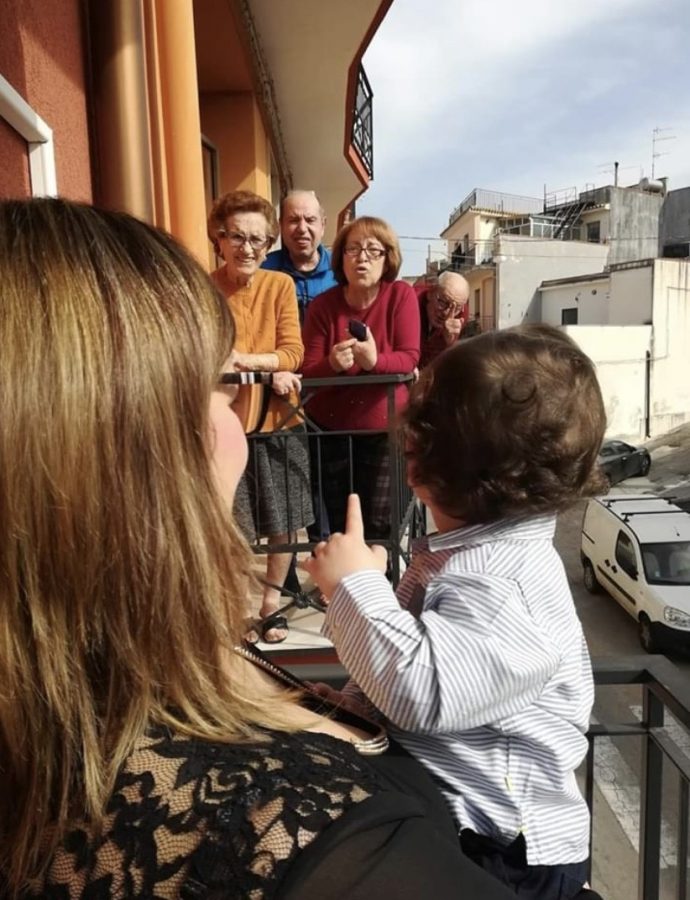Instead of learning from Italy’s coronavirus experience, the United States has replicated it
My cousins in Italy have taught me the tragedy of COVID-19 but also the courage to keep fighting it
While still practicing social distancing, the neighbors of the author’s aunt, Nella Pirruccio, sing “Happy Birthday” to the family’s youngest and newest cousin, Roberto Pirruccio. “It was so special that they took the time to sing to Roberto,” Pirruccio said. “We have become very close with our neighbors.” Photo courtesy of Nella Pirruccio.
May 4, 2020
In the first of a two-part series, senior Mia Terminella writes about how her international relatives are dealing with the COVID-19 pandemic in their home nations.
“Only one time before have I saw St. Peter’s Square completely empty. It was two years ago. During my freshman year of college.” my cousin Carla said, “Guilio and I would walk around the square at night. We walked through Bernini’s colonnade at 2 a.m. and stared at the Vatican glowing.”
While the previous scene was one that occurred three years ago, the images we have seen coming out of Italy now, are a somber reminder of the devastating effect that COVID-19 has had on Italy’s population. The great piazzas are deserted, but with an eerie emptiness. The canals in Venice are clear and full of fish and dolphins, almost as if humans had never been there.
A month ago, when the explosion of COVID-19 began to pick up fuel, one thing ran through my mind. Being a first-generation American, half of my extended family lives in Canada and the other half lives in Italy. With borders closing, and with different governments taking different approaches, the safety of my family in both Canada and in Italy was a huge concern of mine. When talking to both sides of the family about the virus and their way of life, the different way each of our governments was handling the pandemic piqued my interest.
The spread of the virus across the United States and the resulting unprecedented rise in the number of confirmed COVID-19 cases and deaths due to COVID-19 has led many politicians, journalists and other leaders to compare the growth of the virus in the U.S. to its growth in Italy. When the United States overtook Italy for the most COVID-related deaths on April 11, Texas senator John Cornyn even took to Twitter to ask the question, “Is it relevant that the US has 5X the population of Italy?”
His answer seemed to suggest that the United States had responded to the outbreak better than Italy did. I could spend space in this column considering that claim, but honestly, it misses the point entirely. This isn’t a competition between nations. It’s a competition against the virus. What can we learn from comparing the national responses to COVID-19?
I would argue that the responses are more similar than they are different.
Is it relevant that the US has 5X the population of Italy? https://t.co/aTnwRdKeTU
— Senator John Cornyn (@JohnCornyn) April 11, 2020
The pandemic hit Italy about two weeks before it came to the United States.
My cousins Carla and Giulio are still currently quarantined in Rome as they have been since March 9. Both are juniors at the Sapienza University of Rome. Due to the pandemic, their classes have been moved online. Carla and Guilio have been trying to stay positive and to continue with their school work as much possible. As far as quarantine activities, restrictions and allowances, I found our daily routine similar. My cousins told me that they wake up around 2, eat way too much, watch a TV show, and fall back asleep. This routine sounds pretty familiar, doesn’t it?
There is, however, one predominant difference between my COVID-19 experience and that of my Italian cousins. According to their accounts, in Italy, you see the deadly effect of the virus every day with your own eyes.
“There are coffins lined up in churches and hospitals, ambulance sirens ringing day and night, and funeral after funeral with only a priest, a mourner, and a body,” Carla said.
But before we conclude that Italy has had it far worse with COVID-19 than the United States, lets consider what has happened in other parts of our country. Just because I haven’t witnessed the effect of COVID-19 first hand doesn’t mean other Americans haven’t. This fact was made crystal clear to me last week when accounts came out of New York of the death by suicide of top Manhattan E.R. doctor, Lorena M. Breen, Breen had treated many coronavirus patients and even contracted and recovered from COVID-19.
Dr. Breen’s father, Dr. Philip C. Breen, told the Times she simply could not handle the effect that the devastating scenes of the toll the coronavirus took on patients.
“She tried to do her job, and it killed her,” he told the Times, saying that his daughter should be seen as a casualty of the pandemic just like the victims she tried so hard to treat.
In New York, the number of deaths from the virus has led to the addition of refrigerated trucks to hold the bodies of COVID victims. Heart Island, which is just off the coast from the Bronx, has been a place the city buries unidentified, or unclaimed dead, or families that can’t afford a burial. In a series of tweets, New York Mayor Bill de Blasio acknowledged the number of burials had increased.
As it has been hard in New York and Detroit and the West Coast to stay positive in the face of the COVID-19 onslaught, it has also been hard on my cousins.
Guilio said that their “household was doing their best to stay optimistic; however, when your neighbor was taken to the hospital and never returned, your mood changes drastically.”
When the virus first hit Italy, the public’s response to the outbreak was similar to the dismissive response that we experienced here in the U.S.
Harvard researchers Pisano, Sadun, and Zanini warn that Italy suffered from “a systematic failure to absorb and act upon existing information rapidly and effectively rather than a complete lack of knowledge of what to be done.”
The U.S. made the same initial miscalculation.
Just weeks ago, citizens and government officials were still skeptical of why COVID-19 was considered a threat. People were hesitant to panic and the virus was being compared to the seasonal flu. Many high school and college students enjoyed spring break as if nothing was different in the world.
What we didn’t fully appreciate then was that the coronavirus spreads quickly with those who contracted it not showing symptoms for days. The full extent of their illness isn’t apparent (if they do develop the disease) until a week or two after they are infected. Therefore, weeks ago when people were still skeptical, the seeds were planted that caused the outbreak of deaths we are seeing now.
Italy started small with its coronavirus quarantine and expanded it as the scale of the problem was revealed. The country started with a targeted strategy. Certain areas that were experiencing a lot of infections were designated as “red zones.” In these red zones, there were progressive lockdowns depending on how severe the outbreaks in the area were. When these measures did not stop the virus’s spread, the restrictions were then broadened to the whole country.
The U.S. is already deep into a similar response. Trump issued his recommendation on March 15 that people stay at home until to stop the COVID-19 spread, and then on March 29 he announced in a White House briefing that he was extending the stay-home period to April 30. This was the same guideline enacted by Texas Gov. Greg Abbott announced last Monday that he was electing to let expire. While with the president’s support, Texas and 23 other states have at least partially peeled by restrictions to allow businesses to reopen, according to The New York Times on May 4. New York, California, and Washington have almost locked down completely. Others, such as Florida have been reluctant to do the same. New York and New Jersey are attempting to prevent people from entering their borders.
We have seen supply shortages at hospitals and permissive attitudes from some politicians, which could cause an even deadlier outbreak. We have also seen protests at state capitals including our own where people criticize the government for doing too much.
In short, and this is perhaps an understatement, the response to the virus in the U.S. has been mixed.
When I see what is happening here, I look back to my cousins in Italy and feel like the lessons their experiences could have taught us have been ignored. The Italian experience has much to teach us, but America has to be willing to listen.
As a nation, we need to be smart, but we also need to be strong. At least we can take that lesson from my cousins in Italy and put it into practice.
As the death toll begins to slow in Italy (and in places in the United States), my cousins continue to look to the future with optimism.

The author’s cousin Carla has been using most of her time at home to bake. “I made Pan di Spagna, which is like a traditional Italian sponge cake, for Easter this year,” Carla said, “I have learned a ton of new recipes.” Photo by Carla Terminella.
“Italians are immensely resilient,” Guilio said. “I have never known them to lose hope.”
As my grandmother used to say, “Coraggio.” Translated, it means “courage.”
Take heart. Be strong. Be safe. And keep on going.
In the second installment of this two-part series, Terminella will present the COVID-19 experience of her relatives in Canada.




